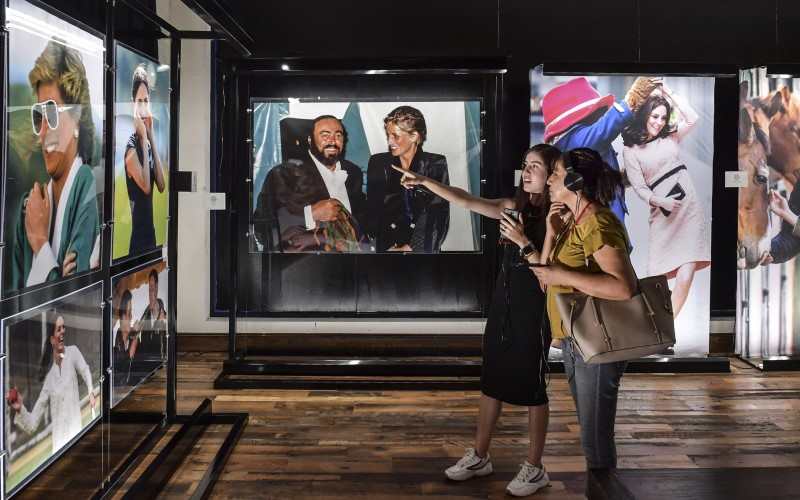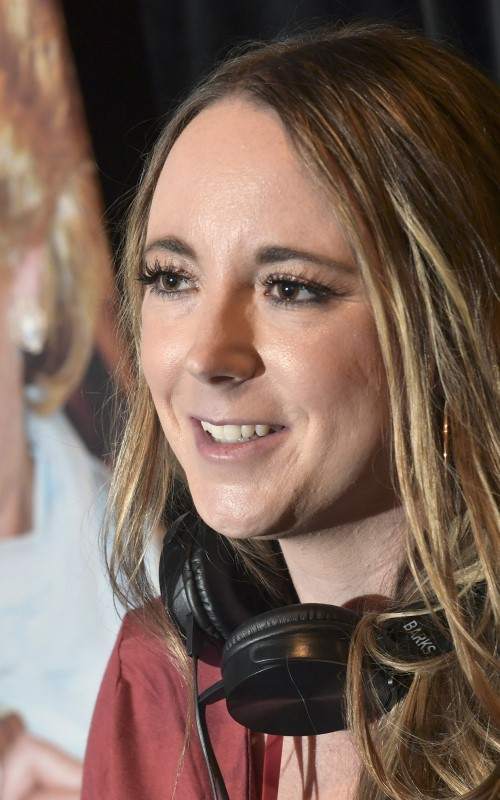Princess Diana died 25 years ago, but she endures as a role model for women

Mariana Orozco, left, and her mother, Anjelica Lozano, are among the fans of Princess Diana who enjoyed a walk through a traveling exhibit about her earlier this month in Virginia.
15:17 JST, August 21, 2022
The story of Diana started like a fairy tale and ended like a Greek tragedy: a handsome prince, a beautiful princess – then fame, betrayal, reinvention and a fatal car crash 25 years ago in Paris.
If Diana had lived happily ever after, today she would be a 61-year-old royal grandmother – older, wiser and probably far less interesting. While Charles has calcified into a state of permanent suspension, Diana has been transformed into an archetype, a symbol of resilience and redemption. She’s Everywoman, or what every woman wants her to be.
“I’ve watched her since I was a little girl,” said Christine Tomsovic, 52, who was visiting a traveling exhibit on Princess Diana at the Tysons Corner mall in Northern Virginia on a recent Saturday. “I watched her get married. I watched everything to her tragic death. I’m just a huge fan.” Diana, she explained, was “caring, compassionate and loving.” She was a humanitarian. And she was different from other royals: “Her personality broke the mold. She was herself. She didn’t let anybody tell her what to do.”
Tomsovic’s eyes filled with tears. “I’m just sad that she’s gone.”
Gone but never, ever forgotten. If anyone thought Diana’s death on Aug. 31, 1997 would finally quell the endless drama and tabloid stories, they were sensationally wrong. An estimated 2 billion people watched her funeral, and the ensuing quarter-century has only burnished her reputation. Her story has been told and retold – recently in Netflix’s “The Crown” and last year’s movie “Spencer” – with the historic narrative landing solidly in Diana’s favor: Charles as a careless and unloving husband, the royal family aloof and controlling, and Diana as a romantic innocent, loving mother, betrayed spouse and forever, triumphantly, the people’s princess.
This romanticized depiction of her is literally on display at the exhibit during this melancholy anniversary. Tomsovic was one of Diana’s admirers – many older, some young, almost all women – who paid $25 for the walk-through tour of more than 100 oversize images: Diana the fashion legend, Diana the trailblazer, Diana the role model.
Diana lived her life “with love, not by rules,” said Mariana Orozco, 26, who was visiting from Mexico. She was just a baby when Diana died, but grew up fascinated by her. Recently engaged, she wore a small blue stone on her left hand: “All my life I said, ‘I would like a sapphire like Diana’s.’ “
“Her beauty and the style draws people in really quickly,” explained exhibit curator Cliff Skelliter. “Then there’s a lot of connectors to what feels like a fairy tale – we love fish-out-of-water stories because they act as a way for us to protect ourselves easily into the character. So when somebody like Diana comes along, all these women who were around the same age, now in their 60s and 70s, projected themselves onto this young lady and forged this strong bond.”
The eight-foot photos were shot by Anwar Hussein – one of the many royal photographers who covered Diana’s every move for her 16 years in the public eye – and his two sons, who shoot Prince William and Prince Harry and their families. Most of the famous images have already appeared in newspapers, magazines and books, but together they serve as a reminder of the short, dazzling trajectory of her life.
“We could tell these anecdotal stories about Princess Diana to really build a picture of her humanity, that she was this real person who was learning in front of a whole bunch of cameras and the whole world watching and not necessarily being perfect, but figuring her way through it,” Skelliter said.
My God, she was so young. There’s a photo of a dewy Diana, newly engaged and delicious, with a charisma beyond her years. In another, Charles and Diana are leaving the church after their 1981 wedding; more than 750 million people all over the world tuned in to witness the ceremony and the famous balcony kiss. The groom was 32 and in love with another woman; the bride just weeks after her 20th birthday.
“I felt sorry for her. I remember thinking, ‘Don’t do it,'” said Lois Wren, 67. Like so many women at the exhibit, Wren remembers waking up at 4 a.m. to watch the royal wedding. She was old enough to worry that the newly minted princess was walking into the lion’s den. “So tragic,” she said, shaking her head. “So tragic.”
Her 31-year-old daughter, Laura, watched Diana’s funeral as a young girl, and her takeaway now is that Diana emerged from that lion’s den unbowed. “I think she was great,” she said. “She didn’t seem like a snob, like other royals. She seemed like a really genuine person.” She pointed to a photo of Diana cradling a sick child. “No other royal does that, not even celebrities do that, maybe not even a decent human does that. But she did it.”
“We’ve always been very intrigued by the royal family,” said Maria Melgar, 25, who came to the exhibit with her mom, Martha. “You hear Diana’s name everywhere. She had such a way of connecting with people. She presented herself as someone you could relate to, one of us.”
History is an unreliable narrator, and many of the nuances of Diana’s life have faded to the background in service of a simpler story. She was no Cinderella: Her family was aristocratic and friends of the queen. She moved in rarefied circles and was destined for a prestigious marriage, although a match with the crown prince was a coup for the Spencer family – Diana was the first English woman to wed an heir to the British throne in more than 300 years.
When that union fell apart, Diana could have retreated to living a quiet, discreet life separate from her husband – but that was not her personality. The unspoken truth in her life (and in the photos) is how much Shy Di loved attention and used the spotlight – first, because she liked it, and later in her ongoing battle with Charles and the royal family. The constant paparazzi ultimately proved to be a Pandora’s box she could not close, but her public service was both a genuine expression of compassion and a way of winning the PR wars.
The exhibit includes the infamous shot of Sad Diana alone at the Taj Mahal (paired with another of William and Kate in the same spot), and Sassy Diana wearing the sexy black “revenge dress” the night Charles publicly admitted his infidelity. Separation, affairs and divorce: The end of the fairy tale was the beginning of Diana’s emergence as a modern role model. She was beautiful and stylish, but it was her vulnerability, her disappointment, her foundering that made her relatable.
“In the beginning, I wasn’t all that interested in her,” Margaret Kizis said. “Once I read Andrew Morton’s biography, I realized it was not all glamour and beauty – that she was suffering a lot.” What Kizis admires most is that Diana turned that suffering into helping others. “We all try to soothe our own pain and that’s not a bad thing to do. The sad thing is that I don’t think she realized how much people loved her in return.”
The 76-year-old has a trove of books, magazine articles, figurines and china about Diana that she hopes to auction for charity one day. “She brought kindness into the world, and she touched so many people who needed love, who needed kindness and who needed some humanity.”

Philadelphia resident Margaret Kizis walks through the Diana photo experience.
That legacy has passed on to Diana’s sons, who have now both outlived their mother. William, 40, seems more like his father as the years go by – not surprising for a man who will become king one day. Harry, who turns 38 next month, always had his mother’s touch and – now unburdened by the weight of royal duties – her defiance and sensitivity. The exhibit includes images of the brothers and their families, a then-and-now nod to her influence and what might have been had she lived.

Taylor Stephens of Alexandria, Va., reflects on Diana.
“I think she was a woman ahead of her years, especially for females,” said Taylor Stephens, 29. “She did a lot for women at that time – you can see it in the way she raised her boys. That set precedent for the rest of the royal family – you can see that with Kate, you can see that with Meghan. She took what was a very reserved royal family and made them more human.”
In the end, history will remember Diana in broad strokes: a beautiful princess, a lonely marriage, a champion of the hurt and disenfranchised, a woman who touched the untouchables.
“One of the things I hope people come out with is that they aspire to represent something good in the world,” said Skelliter, the exhibit curator. “Because Princess Diana did that, right? She showed us an example of how to be this great, engaged mother and how to move her way through an extraordinarily difficult scenario in a very tricky world that’s not perfect. The world’s still like that, and if we could look at her and go, ‘Okay, there’s hope for us,’ that’s a net positive.”
"News Services" POPULAR ARTICLE
JN ACCESS RANKING







